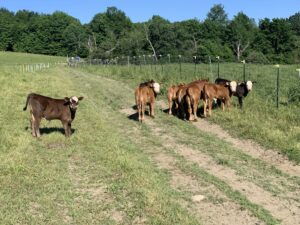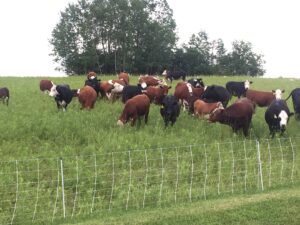Give Stocker Beef Cattle a Chance
In part 12 of our “What’s Your Beef?” series on raising cattle on small farms, we share how stocker cattle can provide a quick, easy way to get into the beef industry without a huge investment.
If you are new to farming, or just want to take a break from the normal paradigm of raising beef cows and calving them out each year, then you might consider raising stocker cattle. A class of cattle known as “stockers” utilize pasture to add weight inexpensively. These are generally young light weight calves born in the previous year, purchased in the spring of their second year, and that graze during the summer. They are then sold at the end of the grazing season to farmers or feedlots that finish them to market weight. Growing stocker cattle requires minimal investment in machinery and buildings compared to other types of beef cattle enterprises. This low barrier to entry provides an exciting opportunity for beginning farmers, whether they be new to agriculture or farmers interested in diversifying. Access to land which can be leased and capital to purchase cattle are the major requirements. New York State does have a fair amount of land that would lend itself very nicely to grazing stocker cattle. The one major requirement that you need is to have a good grazing infrastructure, consisting of good grass, watering systems, and fencing. You don’t even need to own your own land for this type of enterprise and can get into it very nicely with leased grazing lands.

These small calves will make ideal stocker cattle for the following year. Rich Taber / CCE Chenango
“The deal”, in a nutshell, is as follows. Come springtime, you go to livestock auctions and buy calves that were weaned the previous fall, bring them home, and graze them into the fall of their second year. If going to auction barns does not suit you, you can contact an order buyer who attends lots of sales and commission them to procure calves for you. Then you sell them and hopefully make some profit. There are several advantages to this business model:
- You don’t need expensive buildings to house the animals, as this occurs during the warmer months of the year. Little to no cover is needed as the animals are in your possession spring through the fall, avoiding the harsh winter months.
- You don’t need a lot of expensive purchased or self-made hay, as the animals will be grazing for most of their time with you. Pastures, while not free, are indeed a lower input type of enterprise. You will need a little bit of stored hay or baleage to tide you over during dry spells.
- You don’t need to overwinter a bunch of hungry brood cows, thus negating most of the hay requirement. You also avoid the daily requirement of feeding and tending to those cows. You don’t need to fight with an unhappy tractor that might not want to start all that well in the cold weather either. You can avoid howling winds, deep snow, ice, and frozen extremities!
- You don’t need much of any farm equipment to raise these kinds of cattle; maybe a smaller tractor and brush hog to keep pasture paddocks trimmed would suffice.
Like any animal enterprise, you will need to bring your “A Game” with respect to health management and vaccination protocols. You do not want to be purchasing a bunch of calves from different sources and then dump them all together at one time; this is a recipe for disaster. You should consult with a veterinarian ahead of time about the best vaccination schedule. You will need to have a handling facility on the property; stocker calves can be wild and feisty and a squeeze chute is of paramount importance in handling these animals. Some vets will refuse to come to your farm if there’s no way to safely handle the animals. It can be downright dangerous trying to do management protocols on these animals if they are not restrained correctly.

Stocker cattle grazing during the warmer months of the year on rough land. Rich Taber / CCE Chenango
Another consideration is training new animals to your electric fences. New animals might just sail through your existing fences if you bring them home and unload them without proper fence training. You may need to house them in a barnyard with stout perimeter fences as an “insurance policy”. Then you set up electrified hot wires a few inches out from your permanent fences. It won’t take too long to get the animals to get shocked and trained to the hot wires.
As far as grazing goes, you would follow all of the principles of rotational grazing that any other class of grazing animal takes. You are trying to get the animals to gain weight on grass; daily weight gains can range from 1.w to 1.8 pounds per day. You need to have high quality grasses and that the animals move thought different paddocks every 3 to 5 days. You will need a good salt and mineral mix available to the calves as well
Stocker cattle can be an excellent enterprise to “get your feet wet” so to speak, and to see if you like raising cattle. Give them a try!
Source for more Info:
An excellent document providing information on stocker cattle is the “Stocker and Backgrounding Self Assessment” available from the Beef Quality Assurance Program. This can be found at: http://www.nybpa.org/assurance.html and www.bqa.org/Media/BQA/Docs/stocker_assessment.pdf
This is the twelfth installment in our ongoing series of beef management articles for the new and small-scale farmer. Previous versions may be seen in the archives of the Small Farm Quarterly at https://smallfarms.cornell.edu/quarterly/archive/ .

